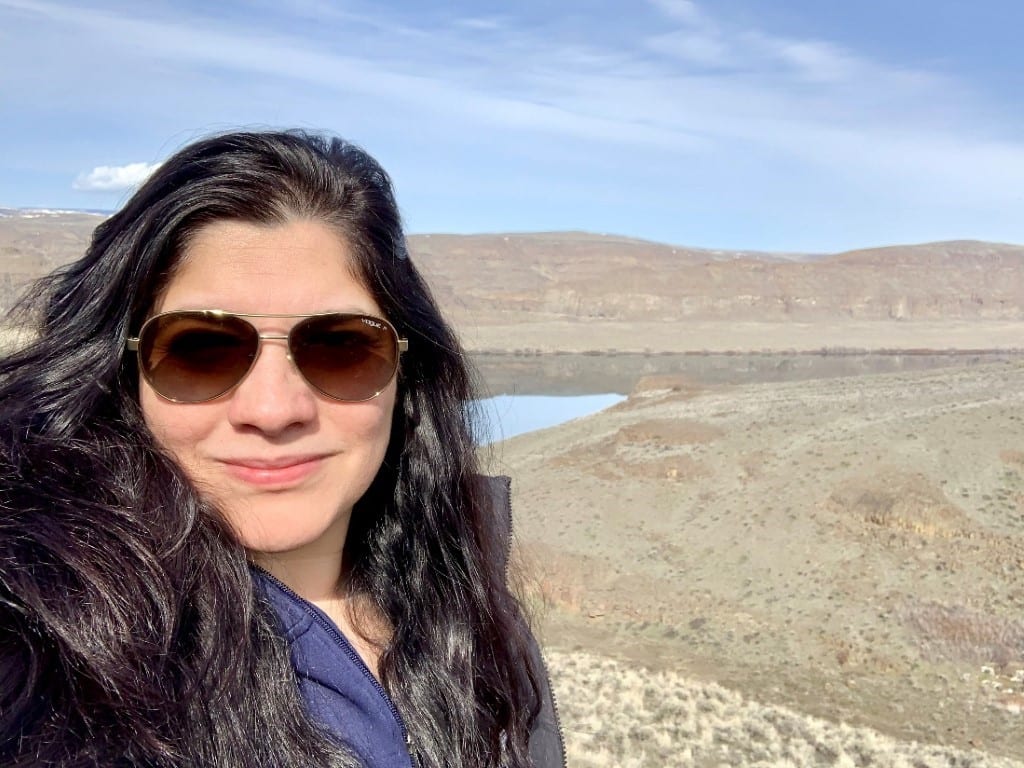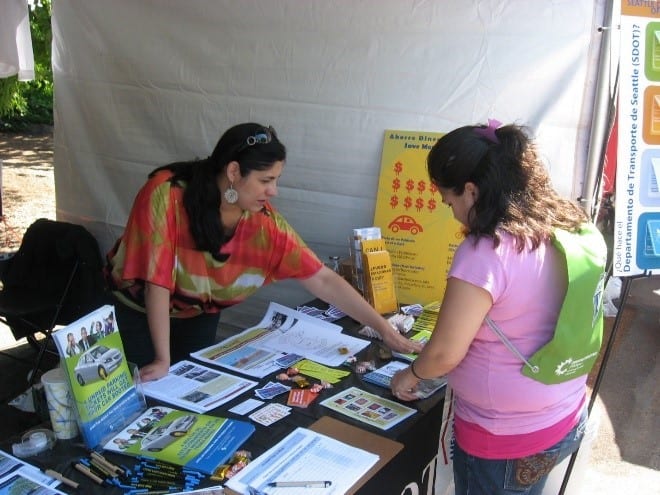 Sonia Palma.
Sonia Palma. In honor of National Hispanic Heritage Month (also known as Latinx Heritage Month), we sat down with Sonia Palma, SDOT’s Customer Service and Incident Response Manager.
Born in Argentina, Sonia grew up in Buenos Aires, Argentina, and New York. In New York, she finished high school and earned a Bachelor’s degree in Biology and a minor in Anthropology from Hofstra University. She also holds a certificate in construction management from the University of Washington, and is a mom to a teenager!
Sonia has worn many hats in her 11+ -year career with the City of Seattle. One of her hats includes her role as the Race and Social Justice Initiative (RSJI) Policy and Development Lead at the Seattle Office for Civil Rights.
Sonia delivered RSJI trainings and presentations to City of Seattle staff. The trainings focused on identifying systemic racism, implicit and explicit bias, and incorporating a racial equity lens into work. She also supported the City’s public engagement process – including putting together the first inclusive outreach public and engagement documentation for the City of Seattle. In 2015, Sonia spoke about creating effective narratives to talk about race and racism at the “Governing for Racial Equity” Conference.
Sonia began her SDOT career as a Project Controls Analyst and Communications/Outreach Specialist for major projects like the Elliot Bay Seawall Project, and the Alaskan Way Viaduct and Seawall Replacement project. Her role eventually transitioned into a Senior Project Funding and Agreements Coordinator where she managed the procurement processes for SDOT consultant contracts.
- She reviewed and kept track of design consultant invoices for these and other projects. She also participated in related public meetings to provide information to attendees in English and Spanish as needed.
- She analyzed Women and Minority Owned Business Enterprise (WMBE) consultant use to make sure SDOT reached or exceeded goals for working with women or minority-owned consultants.
- Sonia worked across departments, including the Mayor’s Office and the Seattle Police Department (SPD), to provide input on issues affecting communities of color.
Today, Sonia’s role as a Customer Service and Incident Response Manager means she is the go-to person for SDOT’s customer service and incident response functions.
- She manages SDOT’s Customer Care Center and 24/7 Radio Dispatch Center. These teams efficiently receive and respond to customer inquiries, complaints, and emergency situations.
- Here is an article Sonia wrote last year about her team’s work!
Sonia considers herself to be a compassionate and strong leader – or, as she says, a “servant leader.”

Sonia with dancers from Tloke Nahuake who performed at the “Dia de Muertos Festival Seattle” in October 2018. 
Sonia dressed as Catrina, the “Lady of the Dead” – one of the most widely recognized symbols of Dia de Muertos.
In and outside of work, she’s always eager to learn and incorporate traditions from different cultures. While Día de Muertos – a Mexican holiday to honor the lives of loved ones who have passed away – is not celebrated in Argentina, she has a passion for celebrating it each year. Dia de Muertos is celebrated from October 31 to November 2 this year. She’s volunteered with the Seattle Center during their Día de Muertos events, most recently as the master of ceremonies (MC).
As an immigrant to the United States, Sonia is committed to taking care of people – especially those who have immigrated from other countries.
Her empathy extends to everyone, even to neighbors she sees at her bank who have trouble communicating in English. She’s there to lend a hand. Her leadership and empathy plays a key role in her work, too. Sonia looks to elevate the voices of the people she works with, especially when citywide changes might affect them and their work.

The SDOT’s Customer Care Center team at the internal team launch. 
Sonia and team at a Snow & Ice event with the Mayor in February 2019.
Outside of her full-time roles, she’s volunteers with the SPD’s Victim Support Team, providing crisis intervention and support to victims of domestic violence and their children.
Sonia has served on SDOT’s internal RSJI Change Team, is a leader among Latino City employees, and has extensive experience engaging communities in civic participation.
Sonia’s first language is Spanish. As an infant, Sonia moved to New York with her family. At age seven, she moved back to Argentina. She eventually returned back to New York at age 16 and relearned how to speak English. While Sonia has always been proud of her Hispanic heritage, there’s one defining moment during her high school sophomore year that has both shaped her professionally and caused her to push aside some of her Hispanic identity.
As an avid lover of theater arts, Sonia joined her high school’s drama club and planned to audition for her high school musical, Anything Goes. She recounts a discouraging comment made by her high school theater teacher about her Spanish accent that kept her from auditioning. This impacted her deeply, and she spent the next couple of years intensely masking her accent.
At times I feel like ‘no soy de aqui, ni soy de alla’ (I’m not from here, and I’m not from there)… Being an immigrant and having roots in two countries sometimes feels like I’m not from one or the other, yet, I’m bi-cultural and have to often manage balance and adjust.
Sonia Palma
There’s power in being bilingual. Sonia’s bilingual abilities have afforded many opportunities to connect with many people – and share SDOT’s stories with Spanish-speaking families in our region.

Sonia with Karina Gasperin of Actitud Latina, after an interview on-camera in September 2016. 
Sonia with Teresa Gonzalez after an interview for Univision in April 2014. 
Sonia during an interview with Horacio Ahumada of Radio Luz 1680AM about the SR99 Tunnel tolls.
Sonia has been asked to take part in a number of public meetings about the Alaskan Way Viaduct in her first role at SDOT. This led to many more public outreach opportunities and media appearances.
One of her early on-camera interviews was about using the “Find It, Fix it” app to report potholes. She remembers having about an hour to learn the information, translate it to Spanish in her head, and prepare for the interview! (Here’s a video of Sonia talking about the tolls on SR-99, and one about getting ready for winter weather!)
When Sonia speaks Spanish on-camera or on the radio, she works hard to adapt her Argentinian Spanish to Spanish more like what is spoken in Mexico or Central America. She explains this is because people of Mexican and Central American descent are many of the Spanish speaking residents in our region.
I like to connect people, to services, and to each other. I like to bring the voices of those who may not be in the room, whether it’s community, or dispatch, or crews. And I want to encourage everyone not to forget where they came from.
Sonia Palma


